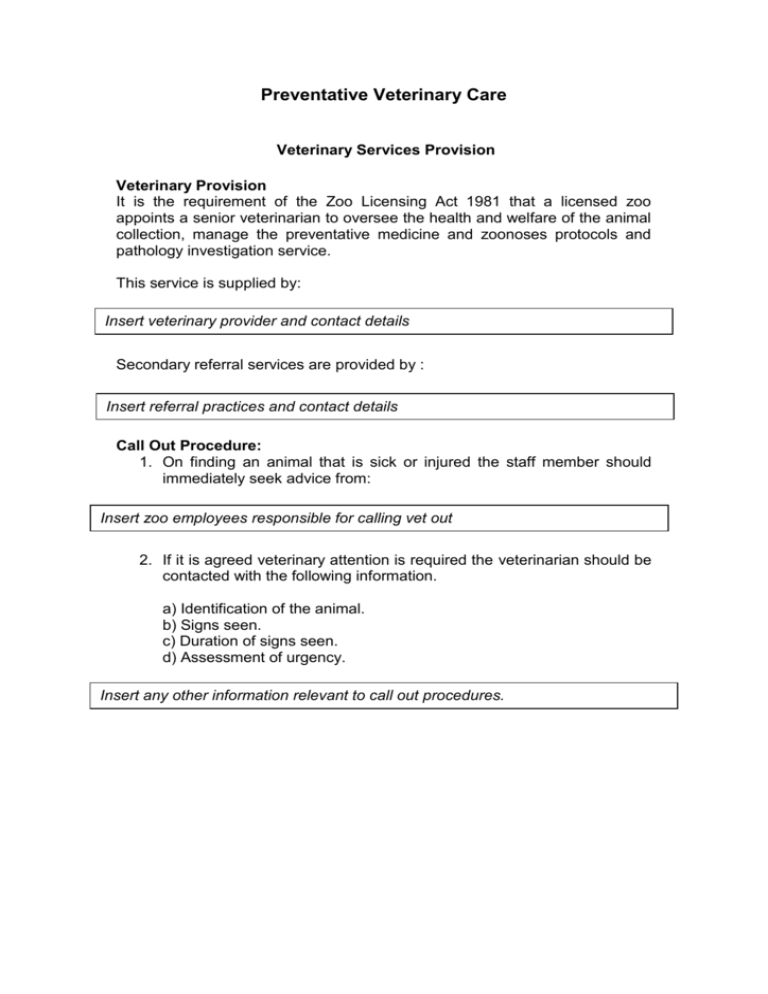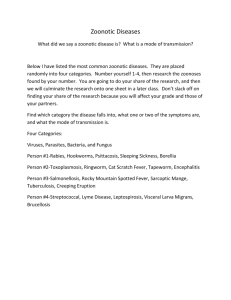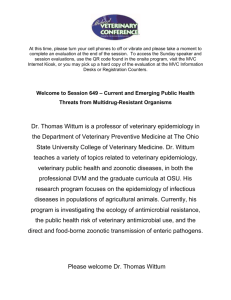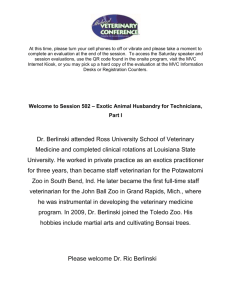- Zoo and Wildlife Solutions
advertisement

Preventative Veterinary Care Veterinary Services Provision Veterinary Provision It is the requirement of the Zoo Licensing Act 1981 that a licensed zoo appoints a senior veterinarian to oversee the health and welfare of the animal collection, manage the preventative medicine and zoonoses protocols and pathology investigation service. This service is supplied by: Insert veterinary provider and contact details Secondary referral services are provided by : Insert referral practices and contact details Call Out Procedure: 1. On finding an animal that is sick or injured the staff member should immediately seek advice from: Insert zoo employees responsible for calling vet out 2. If it is agreed veterinary attention is required the veterinarian should be contacted with the following information. a) Identification of the animal. b) Signs seen. c) Duration of signs seen. d) Assessment of urgency. Insert any other information relevant to call out procedures. Visual Animal Checks All animals at should be given a visual health check first thing in the morning and last thing in the afternoon as well as periodically through out the day. The following should be checked: 1. Does the animal have any visible cuts, grazes, wounds or hair loss ? 2. Is the animal moving normally ? a) Is the animal limping ? b) Is the animal standing normally/comfortably ? c) Is the animal holding a limb in an abnormal position ? 3. Is the animal eating normally ? a) If the animal is a ruminant is it chewing the cud ? b) Is the animal uninterested in the food presented ? c) Is the animal showing normal feeding behaviour ? d) Is there the usual amount of food remaining uneaten ? 4. Are there any discharges from the following, what colour are the discharges, is there any blood ? a) Eyes b) Ears c) Nose d) Mouth e) Rectum f) Vagina g) Penis 5. Is the animal passing normal faeces, is it the normal colour and consistency? Is there any blood, diarrhea or excessive straining ? 6 Is the animal behaving normally ? a) Is it alert ? b) Is it subdued or lethargic ? c) Unusually quiet or unusually vocal ? d) Is it kicking at its side, excessive licking any body part, Head swinging or agitated ? e) Is it teeth grinding ? f) Is it sweating ? h) Is it interacting with the group normally ? Preventative Medicine Programme BIAZA has produced a comprehensive range of guidance documents to assist in the development of Preventative Medicine Programmes. The full set of guidance describes in detail the complex aspects of preventative medicine in zoos and should be used to complete a full programme specific to the individual collection. This document provides a high level template only. For Each Taxon or Species Complete the Following Template Source of Stock Animals should be sourced from known suppliers with a known health status. Refer to: BIAZA Animal Transactions Policy Animal Acquisition Protocol Acquisition Procedure Refer to: BIAZA Disease Management During Transfers Guidelines BALAI Directive Guidelines Required Records, Veterinary Procedures and Certification before Acquisition Insert details specific to your collection Length of Required Isolation or Quarantine (depends on BALAI Status) Insert details specific to your collection Management Whilst in Quarantine or Isolation Insert details specific to your collection Veterinary Procedures During Isolation/Quarantine Insert details specific to your collection Routine Monitoring Temperature and humidity monitors (where relevant) should be in use and the parameters recoded on the animals record on a daily basis. Food consumption should be recorded on the animals record. The animals weight should be recorded on a regular basis. Other information regarding the physiology of the animal should be recorded such snake shedding, moulting, reproductive activity etc. Hooves, claws, nails, beaks etc should be checked and maintained if necessary on a regular basis. Biosecurity and Hygiene Protocols Insert Details of the specific biosecurity and hygiene provisions for this Taxon/Species include frequency of disinfection, paddock cleaning etc. Routine Disease Screening Describe the diagnostic disease testing undertaken for each Taxon/Species Describe in which circumstances animals will be tested eg, routine health examinations, opportunistic etc. Vaccinations Describe the use of any vaccines include disease, frequency, dose and route Endoparasite Control Describe your faecal parasite testing regime Describe the frequency of ‘worming’ – every X weeks or following faecal Parasite testing only Describe the drugs, dose and route Ectoparasite Control Describe any treatments for fleas, mites, lice etc used on a routine basis include drug, dose, route Faecal Bacterial Culture Submission As stated in the Guidance on Management of Zoonoses in Zoos produced jointly by BIAZA, Defra, HSE and HPA. Any screening or monitoring programme needs to take into account the costs associated with such a programme as compared to any likely benefits to human visitors and the animals being tested. Consideration should be given to the validity of test regimes in the species in question and what action would be taken in the event of a positive test result. Routine screening of animals that may be infected with endemic infections such as E.Coli O157, Campylobacter or Salmonella is unlikely to be of any benefit. It may not be possible to prove that a particular animal is negative so all should be treated as potential carriers since excretion can be intermittent and the organism can survive in the environment. Therefore the focus should be on controlling the risk of infection through good personal hygiene measures and good environmental hygiene design. Screening is better focused on the higher hazard but rarer infectious diseases that may be associated with certain animals. Screening animals prior to import and during quarantine is highly recommended as it will reduce the chance of bringing zoonotic organisms into the collection. Explain in which circumstances faecal culture is undertaken End of Species or Taxon Specific Template Post-Mortem Procedure Define which animals will be submitted for PME Who undertakes the gross PME and explain histology submission process Explain storage of the body prior to PME Describe the routine PME protocol including protective clothing requirements Explain how the body should be disposed of. Animal By-Products Management The correct handling, storage and disposal or animal waste products is an important component of the preventative health programme in a zoo. Most zoos will need to be licensed under Animal By-Products Legislation. Refer to: BIAZA Animal By-Products Guidelines Zoonotic Disease Management Due to the risk of transmission of infectious disease (in either direction) between animals and humans, both keeping staff and the public, it is essential that zoos have a documented policy regards management of this risk. Close contact with animal body fluids, faeces and tissues is inevitable and minimising the risk of disease transmission requires well-trained personnel and stringent personal hygiene. BIAZA has published extensive zoonotic disease management guidance for zoos which was developed in conjunction with HSE, HPA and Defra. This document should be used to develop a full risk assessment and management plan. Refer to : BIAZA Zoonoses Management Guidelines General precautionary measures to be followed; 1. Correct handling of all animals, their body fluids, faeces and tissues with respect to zoonotic disease. In other words, strict personal hygiene practices, including the use of protective clothing and prohibition of eating, drinking and smoking in potentially infective areas. Staff hand-washing facilities must be available and used regularly. 2. All staff to alert the medical profession to their nature of employment should they be taken ill. (This process will be supervised by HR department). 3. Potential implementation of a targeted animal health screening programme where circumstances indicate (e.g. instances of tuberculosis, pathogenic enteric bacteria and endo-parasites). 4. Particular care with species of known zoonotic susceptibility or individuals of known zoonotic status, considering them as lifelong carriers. 5. All carcases, body fluids, faeces and tissues to be disposed of in a manner that is not detrimental to public health. 6. The working areas of the zoo are off display and not open to the public. 7. In enclosures, barriers must prevent direct contact between members of the public and zoo stock. 8. Direct animal contact is only allowed under close supervision and hand washing is enforced before and after handling. 9. Where ever possible movement of animals and animal products is separated from public paths, play areas and picnic areas.







